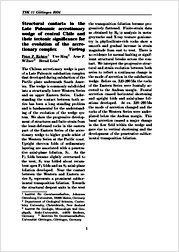Structural contacts in the Late Paleozoic accretionary wedge of central Chile and their tectonic significance for the evolution of the accretionary complex
2006Universitätsverlag Göttingen
Sammelband- / Konferenzbeitrag
Verlagsversion
Deutsch
Richter, Peter P.; Ring, Uwe; Willner, Arne P.; Leiss, Bernd, 2006: Structural contacts in the Late Paleozoic accretionary wedge of central Chile and their tectonic significance for the evolution of the accretionary complex. In: Philipp, S.; Leiss, B; Vollbrecht, A.; Tanner, D.; Gudmundsson, A. (eds.): 11. Symposium "Tektonik, Struktur- und Kristallingeologie"; 2006, Univ.-Verl. Göttingen, p. 179 - 180., , DOI: 10.23689/fidgeo-1836.
 |
Dokument öffnen: |
The Chilean accretionary wedge is part
of a Late Paleozoic subduction complex
that developed during subduction of the
Pacific plate underneath South America.
The wedge is commonly subdivided
into a structurally lower Western Series
and an upper Eastern Series. Understanding
the contact between both series
has been a long standing problem
and is fundamental for the understanding
of the evolution of the wedge system.
We show the progressive development
of structures and finite strain from
the least-deformed rocks in the eastern
part of the Eastern Series of the accretionary
wedge to higher grade schist of
the Western Series at the Pacific coast...

